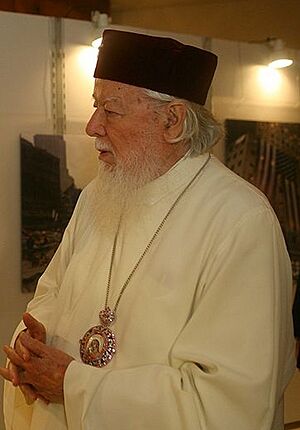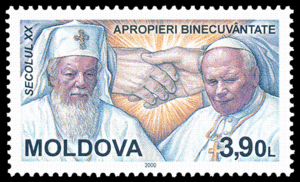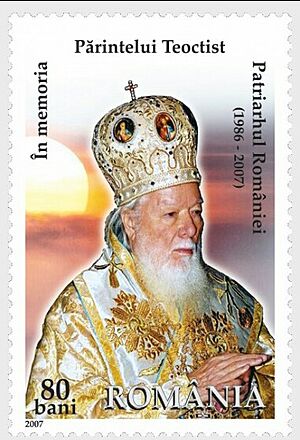Teoctist Arăpașu facts for kids
Quick facts for kids His Beatitude Teoctist Grand Cross and Sash ranks of the Order of the Star of Romania |
|
|---|---|
| By God's mercy, Archbishop of Bucharest, Metropolitan of Muntenia and Dobrogea, Locum tenens of the throne of Caesarea Cappadociae and Patriarch of the Romanian Orthodox Church, His Beatitude Patriarch Teoctist, Patriarch of All Romania |
|
 |
|
| Church | Romanian Orthodox Church |
| See | Bucharest |
| Enthroned | 16 November 1986 |
| Reign ended | 30 July 2007 |
| Predecessor | Patriarch Iustin of Romania |
| Successor | Patriarch Daniel of Romania |
| Orders | |
| Ordination | 25 March 1945 |
| Consecration | 5 March 1950 |
| Personal details | |
| Birth name | Toader Arapașu |
| Born | 7 February 1915 Tocileni, Botoșani County |
| Died | 30 July 2007 (aged 92) Bucharest |
| Buried | Romanian Patriarchal Cathedral |
| Nationality | Romanian |
| Denomination | Eastern Orthodox |
| Parents | Dumitru Arapașu Marghioala Arapașu |
| Alma mater | Faculty of Orthodox Theology |
Teoctist (born Toader Arăpașu, 7 February 1915 – 30 July 2007) was an important leader of the Romanian Orthodox Church. He served as its Patriarch from 1986 until his death in 2007.
Patriarch Teoctist led the church during a time of big changes in Romania. He was known for trying to bring different Christian churches closer together. For example, he invited Pope John Paul II to visit Romania in 1999. This was a very special event. It was the first time a Pope had visited a country where most people are Eastern Orthodox since the East-West Schism in 1054.
Contents
Early Life and Education
Teoctist, whose birth name was Toader Arăpașu, was born on 7 February 1915. He was the tenth of eleven children in his family. His parents were Dumitru and Marghioala Arăpașu. They lived in a place called Tocileni, which is in Botoșani County, Romania.
He went to primary school in Tocileni from 1921 to 1927. After finishing school, he decided to join a monastery.
Becoming a Monk
In 1928, Toader Arăpașu became a novice, which is someone who is preparing to become a monk. He started at the Sihăstria Voronei hermitage. Later, he moved to Vorona Monastery.
He officially became a monk on 6 August 1935. This happened at the Bistrița-Neamț Monastery.
Studying Theology
In 1940, Teoctist began studying at the Theology School. This school was part of the University of Bucharest. He worked hard and graduated in 1945.
After graduating, he continued his religious journey. On 25 March 1945, he became a hieromonk in Iași. A hieromonk is a monk who is also a priest. In 1946, he became an archimandrite, which is a higher rank for a monk-priest. He also studied Literature and Philosophy at the University of Iași between 1946 and 1947.
Becoming a Church Leader
In 1948, Justinian became the Patriarch of Romania. In 1950, Teoctist became a special bishop called a patriarchal bishop-vicar. He also served as the secretary of the Holy Synod. The Holy Synod is the main governing body of the Romanian Orthodox Church. From 1950 to 1954, he was also the head of the Theological Institute of Bucharest.
Rising Through the Ranks
Teoctist continued to advance in the church. In 1962, he was named the Bishop of Arad. In 1973, he became the archbishop of Craiova. He also became the Metropolitan of Oltenia. A Metropolitan is a bishop who oversees several dioceses.
In 1977, he became the Metropolitan of Moldavia and Suceava. These roles showed his growing importance in the church.
Becoming Patriarch
In 1986, Teoctist reached the highest position in the Romanian Orthodox Church. He became the Patriarch. This meant he was the main leader of the church in Romania.
| Styles of Patriarch Teoctist of Romania |
|
|---|---|
| Reference style | His Beatitude |
| Spoken style | Your Beatitude |
| Religious style | Patriarch |
The 1989 Revolution and After
The year 1989 was a very important time in Romania. The Romanian Revolution of 1989 began in December. This revolution led to the end of the Communist government in Romania.
After the revolution, Patriarch Teoctist offered to resign from his position. However, he was soon asked to return to his role. He continued to serve as Patriarch for another 17 years.
Important Activities After 1989

After 1989, Patriarch Teoctist worked to improve religious education. He helped create new schools for theology. These schools trained future priests and church leaders. He also started schools for church singers and for restoring old churches. He helped students get scholarships to study abroad.
Historic Papal Visit
One of the most famous events during his time as Patriarch was in May 1999. Patriarch Teoctist welcomed Pope John Paul II to Romania. This was a truly historic visit. It was the first time a Pope had visited a country where most people are Eastern Orthodox since the Great Schism in 1054. This event had separated the Eastern Orthodox and Western Catholic churches.
When the Pope arrived, Patriarch Teoctist and the President of Romania, Emil Constantinescu, greeted him. The Patriarch spoke about the importance of Christian unity. On 9 May, both the Pope and the Patriarch attended each other's worship services. Huge crowds of people, hundreds of thousands, came to see these services. They were held outdoors. This visit was a big step towards better understanding between the two churches.
Death and Legacy
Patriarch Teoctist passed away on 30 July 2007. He had undergone surgery in Bucharest. Doctors said his death was due to heart problems. He was 92 years old.
His body was placed in the Romanian Patriarchal Cathedral in Bucharest. Many people came to pay their respects.
Funeral and Mourning
The Holy Synod of the Romanian Orthodox Church decided that his burial would be on Friday, 3 August 2007. The Romanian Government declared that day a National Day of Mourning. This meant it was a day for the country to remember and honor him.
The funeral service took place at the Patriarchal Cathedral. The Ecumenical Patriarch Bartholomew I led the service. Many other church leaders from Romania and other Orthodox countries were also there. After the religious service, Patriarch Teoctist was given state honors.
Delegations from 30 Orthodox Churches attended the funeral. Representatives from many other Christian churches and religious communities were also present. About 8,000 people came to the funeral. Patriarch Teoctist is remembered for his leadership and his efforts to promote unity among Christians.
Images for kids





